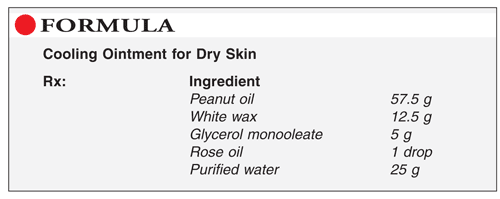
Method of Preparation: Calculate the quantity of each ingredient for the amount to be prepared. Accurately weigh or measure each ingredient. Using low to medium heat, combine the peanut oil, white wax, and glycerol monooleate. When the ingredients are uniformly mixed, cool while stirring. While the mixture is still soft, incorporate the water in small portions and mix well. When the mixture reaches room temperature, add the rose oil and mix well. Package and label.
Use: Cooling ointment may be used on dry and/or irritated skin. It is especially useful during the winter months.
Packaging: Package in tight, light-resistant containers.Labeling: For external use only. Keep out of the reach of children. Discard after 30 days.
Stability: A beyond-use date of 30 days may be used for this preparation. This mixture contains no preservatives.1Quality Control: Quality-control assessment can include theoretical weight compared with actual weight, specific gravity (SG), active drug assay, color, texture-surface, texture-spatula spread, appearance, feel, rheologic properties, and physical observations.2
Discussion: Unguentum leniens FNA (cooling ointment, cold cream) is used in different parts of the world with some variations in the formula. White wax may be replaced with yellow wax, glyceryl monooleate with cetyl palmitate, and peanut oil with almond oil. The formula known as Petrolatum Rose Water Ointment USP (cold cream) contains cetyl esters, wax, white wax, mineral oil, sodium borate, and purified water. The formula presented here is relatively simple, easily modified, and very useful during the cold, dry winter months for treating dry skin resulting from low-humidity indoor environments.3Peanut oil (earthnut oil, groundnut oil, katchung oil, nut oil) is a colorless or pale yellow-colored liquid with a bland, nutty taste and a faint, nutty odor. It is generally composed of the glycerides of about 56% oleic acid, 26% linoleic acid, and 8.3% palmitic acid, and less than 5% arachidic acid, behenic acid, stearic acid, and lignoceric acid. Peanut oil is used as an oleaginous vehicle and solvent. It has a density of about 0.910 to 0.915 and a freezing point of -5˚C. If cooled to about 3˚C, it will become cloudy and partially solidify as the temperature is further lowered. It is very slightly soluble in 95% ethanol and soluble in oils. Peanut oil is relatively stable, but it can slowly thicken and become rancid upon exposure to air.4
White wax (white beeswax, cera alba, bleached wax) occurs as a yellowish-white solid that is somewhat translucent in thin layers. It has a faint, characteristic odor and is free from rancidity. White wax is a chemically bleached form of yellow wax and is used in similar applications. It has an SG of about 0.95 to 0.96 and melts at about 61˚C to 65˚C. It is insoluble in water and sparingly soluble in cold alcohol. White wax is completely soluble in ether and in fixed and volatile oils. It is used as a stiffening agent, emulsion stabilizer, and controlled-release vehicle.5
Glycerol monooleate consists of mixtures of monoacylglycerols, mainly monooleoyl glycerol, along with variable quantities of di- and triacylglycerols. It occurs as an amber, oily liquid that may partially solidify at room temperature. It is practically insoluble in water and freely soluble in dichloromethane. It should be stored in airtight containers and protected from light.6
Rose oil is the volatile oil distilled with steam from the fresh flower of Rosa gallica, Rosa damascena, Rosa alba, Rosa centifolia, and varieties of these species (Rosaceae). It occurs as a colorless or yellow liquid with the characteristic rose odor. When cooled, rose oil changes to a translucent, crystalline mass that is easily liquefied by warming. It should be stored in well-filled airtight containers.6
Purified water is water that is obtained by distillation, ion exchange, reverse osmosis, or some other suitable process. Water has an SG of 0.9971 at room temperature, a melting point of 0˚C, and a boiling point of 100˚C. It is miscible with most polar solvents and is chemically stable in all physical states (ice, liquid, and steam).7
REFERENCES
1. USP Pharmacists' Pharmacopeia. Rockville, MD: US Pharmacopeial Convention, Inc; 2005:775-779.
2. Allen LV Jr. Standard operating procedure for performing physical quality assessment of ointments/creams/gels. IJPC. 1998;2:308-309.
3. Reilly WJ Jr. Pharmaceutical necessities. In: Remington: The Science and Practice of Pharmacy. 21st ed. Baltimore, MD: Lippincott Williams & Wilkins; 2006:1078.
4. Kibbe AH. Peanut oil. In: Rowe RC, Sheskey PJ, Quinn ME, eds. Handbook of Pharmaceutical Excipients. 6th ed. London, England: Pharmaceutical Press; 2009:476-477.
5. Kibbe AH. White wax. In: Rowe RC, Sheskey PJ, Quinn ME, eds. Handbook of Pharmaceutical Excipients. 6th ed. London, England: Pharmaceutical Press; 2009:779-780.
6. Sweetman SC, ed. Martindale: The Complete Drug Reference. London, England: Pharmaceutical Press; 2009:1915,2381.
7. Dubash D, Shah U. Water. In: Rowe RC, Sheskey PJ, Quinn ME, eds. Handbook of Pharmaceutical Excipients. 6th ed. London, England: Pharmaceutical Press; 2009:766-770.





